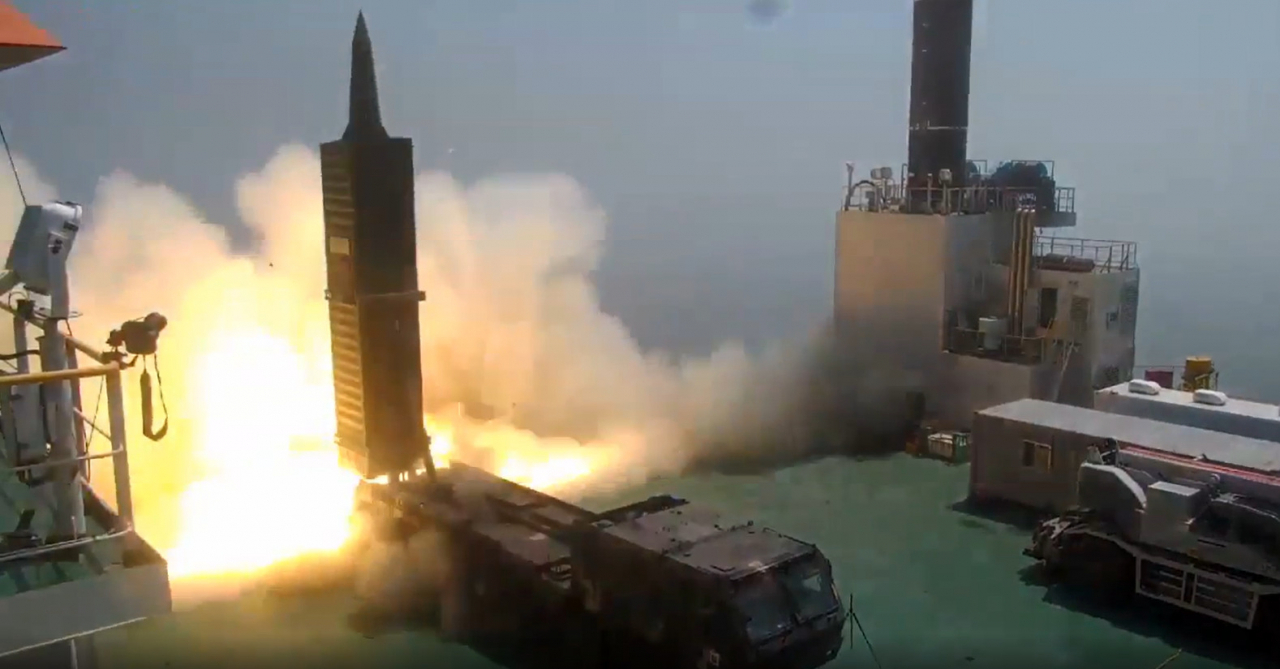Full-scale inspection begins over S. Korea’s Hyunmoo missile malfunction
By Ji Da-gyumPublished : Dec. 16, 2022 - 10:51

After a two-month long initial inter-agency investigation, the South Korean military announced during a closed-door briefing Thursday the outcome regarding the malfunction of a Hyunmoo 2-C ballistic missile. Further full-scale inspections to determine the precise cause of the accident will occur December to March next year.
The military will focus on examining missile navigation, control and guidance systems during the inspections.
The Hyunmoo 2-C ballistic missile crashed into a golf course located within a South Korean Air Force base in the city of Gangneung, Gangwon Province, less than one minute after it was launched at the base on October 4. The missile was aimed toward the East Sea, but the malfunctioned missile abnormally flew westward.
The military concluded the “presumed” cause for the malfunctioned launch lie in an indigenously-developed gyroscope, which is part of the missile’s inertial navigation system, South Korea’s senior defense officials said on condition of anonymity. A gyroscope measures orientation and angular speed and provides position information to guide a missile to its intended target.
Generally speaking, a failed missile launch caused by an error in a gyroscope is “extremely rare.”
One official said the complex structure of a gyroscope and the absence of data on the abortive missile launch such as flight altitude and speed were key factors in failure to find the precise cause of the malfunction despite simulating the accident in more than 30,000 experiments.
The military faced blistering criticism in October due to its slow response to the accident, baffling residents in the coastal city of Gangneung. The fire and loud noise from the crash triggered panic among residents late in the evening, but it was not until next morning the military addressed the cause.
Furthermore, a safety issue was raised after the military admitted the nearest residential house was located 700 meters away from the missile crash site.
The South Korean military pledged to develop a “missile flight safety system” to forcibly and safely terminate the flight of a missile should it deviate from the predetermined flight path, according to officials.
The South Korean military also promised to reinforce its process to inform local residents of live-fire drills in advance.
The October incident marked the first time a launch of a Hyunmoo-2C surface-to-surface missile with a range of 1,000 kilometers has failed since first deployed in 2017. It is also the second failed launch of a Hyunmoo-type missile, which is a key component of South Korea’s three-axis defense system, during live-fire drills. A Hyunmoo-2A missile previously crashed into the sea September 2017.







![[Graphic News] More Koreans say they plan long-distance trips this year](http://res.heraldm.com/phpwas/restmb_idxmake.php?idx=644&simg=/content/image/2024/04/17/20240417050828_0.gif&u=)
![[KH Explains] Hyundai's full hybrid edge to pay off amid slow transition to pure EVs](http://res.heraldm.com/phpwas/restmb_idxmake.php?idx=644&simg=/content/image/2024/04/18/20240418050645_0.jpg&u=20240419100350)






![[From the Scene] Monks, Buddhists hail return of remains of Buddhas](http://res.heraldm.com/phpwas/restmb_idxmake.php?idx=652&simg=/content/image/2024/04/19/20240419050617_0.jpg&u=20240419175937)

![[KH Explains] Hyundai's full hybrid edge to pay off amid slow transition to pure EVs](http://res.heraldm.com/phpwas/restmb_idxmake.php?idx=652&simg=/content/image/2024/04/18/20240418050645_0.jpg&u=20240419100350)

![[Today’s K-pop] Illit drops debut single remix](http://res.heraldm.com/phpwas/restmb_idxmake.php?idx=642&simg=/content/image/2024/04/19/20240419050612_0.jpg&u=)